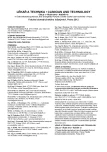Determination of Human Gait Phase by Zero-moment Point
This paper discuss approach to gait phase determination via fuzzy inference. The stability criteria applied to biped robots, namely Zero Moment Point (ZMP) have been employed. Designed fuzzy inference system uses data about the ZMP position. Gait phase is the output of our fuzzy system. Simplified human body model is introduced for computation of ZMP. Both inter - and intra-subject phase identification are examined. The developed fuzzy-rules based system is exemplified to show capability of different subjects gait data generalization. Results of designed fuzzy IF-THEN rules based system show that the proposed method is suitable for this type of task.
We designed system to identify gait phases, which could potentially help to assess the quality of walking. Although the method for studying ZMP in combination with fuzzy logic could contribute to the design of new prosthesis and the diagnosis of disorders, this issue has not been systematically studied in the past.
Keywords:
gait phase, gait modeling, ZMP, zero-moment point
Autoři:
Slavka Viteckova 1; Patrik Kutilek 1; Zdenek Svoboda 2; Jan Kauler 1; Marcel Jirina 1
Působiště autorů:
Czech Technical University in Prague, Faculty of Biomedical Engineering, Kladno, Czech Republic
1; Palacky University in Olomouc, Faculty of Physical Culture, Olomouc, Czech Republic
2
Vyšlo v časopise:
Lékař a technika - Clinician and Technology No. 3, 2012, 42, 21-24
Souhrn
This paper discuss approach to gait phase determination via fuzzy inference. The stability criteria applied to biped robots, namely Zero Moment Point (ZMP) have been employed. Designed fuzzy inference system uses data about the ZMP position. Gait phase is the output of our fuzzy system. Simplified human body model is introduced for computation of ZMP. Both inter - and intra-subject phase identification are examined. The developed fuzzy-rules based system is exemplified to show capability of different subjects gait data generalization. Results of designed fuzzy IF-THEN rules based system show that the proposed method is suitable for this type of task.
We designed system to identify gait phases, which could potentially help to assess the quality of walking. Although the method for studying ZMP in combination with fuzzy logic could contribute to the design of new prosthesis and the diagnosis of disorders, this issue has not been systematically studied in the past.
Keywords:
gait phase, gait modeling, ZMP, zero-moment point
Zdroje
[1] Zoss, A. and Kazerooni, H. (2006). Design of an electrically actuated lower extremity exoskeleton, Advanced Robotics, 20(9), 967-988.
[2] Kawamoto, H., Lee, S., Kanbe, S., and Sankai, Y. (2003). Power assist method for HAL-3 using EMG-based feedback controller, 2(), 1648-1653.
[3] Kawamoto, H., Hayashi, T., Sakurai, T., Eguchi, K., and Sankai, Y. (2009). Development of single leg version of HAL for hemiplegia, , (), 5038-5043.
[4] Mrozowski, J., Awrejcewicz, J., and Bamberski, P. (2007). Analysis of stability of the human gait, JOURNAL OF THEORETICAL AND APPLIED MECHANICSWARSAW, 45(1), 91.
[5] Vukobratović, M. and Stepanenko, J. (1972). On the stability of anthropomorphic systems, Mathematical Biosciences, 15(1-2), 1-37.
[6] Goswami, A. (1999). Postural Stability of Biped Robots and Foot Rotation Indicator (FRI) Point, International Journal of Robotic Research, 18(6).
[7] Goswami, A. (1999). Foot-Rotation Indicator (FRI) Point: A New Gait Planning Tool to Evaluate Postural Stability of Biped Robots, , (), 47-52.
[8] Vukobratović, M., Borovac, B., and Šurdilović, D. (2001). Zero-Moment Point - Proper Interpretation and New Applications.
[9] Vukobratović, M. and Borovac, B. (2004). ZERO-MOMENT POINT - THIRTY FIVE YEARS OF ITS LIFE, International Journal of Humanoid Robotics.
[10] Huang, Q., Yokoi, K., Kajita, S., Kaneko, K., Arai, H., Koyachi, N., and Tanie, K. (2001). Planning Walking Patterns for a Biped Robot, IEEE Transactions on Robotics and Automation, 17(), 280-289.
[11] Dekker, M. H. P. (2009). ZERO-MOMENT POINT METHOD FOR STABLE BIPED WALKING.
[12] Winter, D. A. (2005). Biomechanics and Motor Control of Human Movement.
Štítky
BiomedicínaČlánok vyšiel v časopise
Lékař a technika

2012 Číslo 3
Najčítanejšie v tomto čísle
- Leksell gamma knife past, present and future
- Stanovení pohybové aktivity na základě výsledků zátěžového vyšetření
- Vliv fotodynamické terapie na cytomechaniku nádorové buněčné linie HeLa
- Inovace praktických úloh ve výuce lékařské biofyziky Lékařské fakulty univerzity palackého
